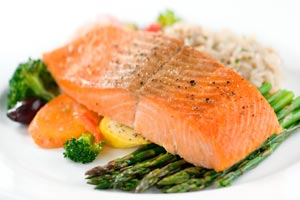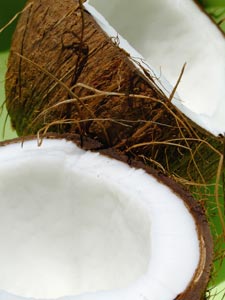Daily consumption for optimum health
03/21/2007
Furci Home / Fitness Channel / Bullz-Eye Home
In a previous article, "Everything in Moderation, Right?", I discussed seven of the worst foods and ingredients you can put into your body. These items are so unhealthy, I feel there is no room for moderation and warn against consuming them at all. As a follow-up, I thought I should educate my readers on substances so vital to their health that daily consumption is a must.
Unfortunately for Americans, the food industry has little or no oversight from the government and has thereby created a food supply almost completely devoid of any nutrition. Everything from beef to bread to milk is overly processed and stripped of its naturally occurring nutrients.
Take salmon, for instance. Most of what you see in the grocery store, unless it is labeled "wild caught," is farmed. What they don't tell you is the farmed salmon contains 60 percent more fat because they are in pens, but it has much less of the beneficial Omega-3 fatty acids.
Perhaps most disturbing is the fact that more than 100,000 salmon can be in one pen with no filtration system. These fish are excreting and living in their own wastes. Findings from a study show that farmed salmon have three to 15 times more organic pollutants than their wild caught counterparts. [1] In 2004, Science Journal warned that farmed salmon contain 10 times more toxins (PCBs, dioxin, etc.) than wild caught salmon. The study recommends that farmed salmon be eaten only once a month, perhaps every two months as it poses a cancer risk to humans. [2]
This is just one example out of the tens of thousands that are littered throughout your grocery store. It's almost overwhelming, but there is something you can do about it. First and foremost is to eat whole, natural foods. Secondly, I recommend supplements wholeheartedly. Anybody who says in this day and age that we can get the nutrition we need out of our food is living in complete ignorance.
You'll find many of these idiots are members of the American Dietetics Association and the American Medical Association. These organizations should be on top of things, on the cutting edge, especially when our health is concerned, but they're not. The AMA, concerning nutrition, is inept and the ADA is a ridiculous organization that still recommends polyunsaturated oils and abides by the food guide pyramid. [3] When big money is involved, as with the food industry, the truth becomes blurred behind statistics and marketing. So who can you trust, and where can you turn for information?
Me, right where you're at, Bullz-Eye.com. Convenient, huh?
Omega-3 fatty acids
 Let's first discuss the basics of fats. A fatty acid is a molecule that is made up of a chain of carbon atoms. These chains can vary in length from one to 24 carbons. Fatty acids are given their names based on how long the chain is and at what position the "unsaturation" occurs. If the fatty acid is saturated, then the carbon chain length determines the name.
Let's first discuss the basics of fats. A fatty acid is a molecule that is made up of a chain of carbon atoms. These chains can vary in length from one to 24 carbons. Fatty acids are given their names based on how long the chain is and at what position the "unsaturation" occurs. If the fatty acid is saturated, then the carbon chain length determines the name.
What is a saturated fat? Each carbon atom in the fatty acid chain has room for two hydrogen molecules, except at the end where it has room for three. A fatty acid possessing two hydrogen atoms for every carbon atom in the chain is said to be saturated. A fatty acid missing two or more hydrogen atoms along the chain, which causes double bonds between carbon atoms, is said to be unsaturated. If there is one double bond, the fatty acid is referred to as monounsaturated. If there are two or more double bonds found along the chain, the fatty acid is referred to as polyunsaturated.
Omega-3 fatty acids are polyunsaturated and refer to a family of fatty acids where the first double bond occurs in the third position. In previous articles and columns, I've discussed the fact that polyunsaturated fats/oils should be avoided.
I warn against consuming polyunsaturated oils that are high in Omega-6 fatty acids, which are highly unstable when exposed to heat or oxygen. Because they are so fragile, the polyunsaturated oils you buy in grocery stores are already rancid from the extraction process.
Omega-3 fatty acids are highly unstable also, but I do not recommend obtaining them from store bought oils. The best way to obtain these essential fatty acids is to consume them in their original packaging like wild caught fish and/or to take a quality supplement. I highly recommend Carlson's fish oil.
Omega-3 fatty acids have been referred to as a miracle fat, and with good reason. The correlation between so many of today's diseases and a deficiency, or in some cases a complete lack of these fats, in Americans' diets is very strong. From our brain to our heart to our skin, the benefits that consuming Omega-3 fatty acids has on our bodies is indisputable.
Omega-3 and depression:
Omega-3 fats fight depression by altering the brain's neurotransmitters, increasing serotonin receptors and boosting dopamine levels in the frontal lobes. Dopamine is a substance that basically makes you more excited about life. It has been shown to increase drive and motivation, which is generally lacking in depressed people. [4]
Omega-3 and heart disease:
We know that inflammation plays a major role in causing heart disease. Animal studies and clinical trials have shown us that Omega-3 fatty acids have anti-inflammatory properties. Omega-6 fatty acids, on the other hand, have been shown to be pro-inflammatory. [5] Just one more reason to avoid eating polyunsaturated oils. Several studies show an inverse association between fish consumption and heart disease. Fish consumption seems to be beneficial, and a systematic review of 11 prospective cohort studies concluded that fish intake notably reduced overall mortality due to heart disease in populations who were at increased risk. [6]
Omega-3 and autoimmune disorders:
There have been a number of clinical trials assessing the benefits of dietary supplementation with fish oils in several inflammatory and autoimmune diseases in humans, including rheumatoid arthritis, Crohn's disease, ulcerative colitis, psoriasis, lupus erythematosus, multiple sclerosis and migraine headaches. Many of the placebo-controlled trials of fish oil in chronic inflammatory diseases reveal significant benefits, including decreased disease activity and a lowered use of anti-inflammatory drugs. [5]
Other positive effects of Omega-3: [4, 7]
- Decrease risk of arrhythmias, which can lead to sudden cardiac death
- Decrease triglyceride levels
- Decrease the growth rate of atherosclerotic plaque
- Lower blood pressure
- Protect baby's brain
- Prevent and treat cancer
- Improve immunity
- Reduce premature births
Sources of Omega-3:
- Wild caught fish like salmon, sardines, mackerel, herring and trout.
- Fish oil supplements like Carlson's
CoQ10
Coenzyme Q10 (CoQ10), or umbiquinone, is considered to be a non-essential nutrient because our bodies manufacture it. CoQ10 is only found in animal products, mainly red meat. CoQ10's key role is producing adenosine triphosphate (ATP), which is essential for energy production in every cell. [8]
CoQ10 is found in most body tissues, with the highest amounts being in the heart. This makes sense considering the heart is the most energetic part of our body, beating 115,000 times per day. The amount of CoQ10 found in body tissues reduces after the age of 20. Our ability to synthesize CoQ10 falls strikingly after age 50. This is a problem, considering CoQ10 is helpful in reducing inflammation and has been successfully used in the treatment of heart disease. [9, 10, 11]
Some of the most common drugs used to treat heart disease are statins. Drugs like Lipitor, Zocor, and Crestor are used to treat people with supposed high levels of cholesterol, which has been hypothesized (Lipid Hypothesis) to cause heart disease. Formally referred to as HMG-CoA reductase inhibitors, these drugs (statins) work by inhibiting the enzyme HMG-CoA reductase. Inhibiting this enzyme does reduce cholesterol levels, but also reduces the production of CoQ10. CoQ10 is a vital component to all cells in our body and is a very powerful antioxidant (50 times stronger than vitamin E.)
A decreased ability to synthesize CoQ10 with age, compounded with a decreased ability to synthesize CoQ10 with statins, is a recipe for disaster. Depletion of this essential enzyme can lead to fatigue, muscle soreness, muscle weakness and heart failure, which happen to be the most common complaints of statin users.
CoQ10 has been shown to be essential for a proper functioning heart as well as preventing heart disease and stroke. In fact, aside from being an energy producer, CoQ10 is the first line of defense against the oxidation of LDL cholesterol, which is the main reaction in atherosclerosis. [12, 13, 11]
Other positive effects of CoQ10: [14, 15, 16]
- Slows the aging process
- Increases energy
- Improves immune function
- Promotes weight loss
- Enhances endurance and aerobic performance
- Lowers blood pressure
- Protects the brain against disease (Alzheimer's, Parkinson's, Lou Gehrig's)
- Combats migrane headaches
- Possible complementary or alternative treatment for cancer
Sources of CoQ10:
Modern farming practices have dramatically decreased the availability of this vital nutrient. Your best bet is to take a supplement, 25 to 100mg per day.
Coconut oil
 Taken from the fruit portion of the seed off the coconut palm tree, coconut oil is one the most beneficial foods you can consume. In tropical regions where coconut oil or fat is a large portion of their caloric intake, people are much healthier and experience a much lower incidence of the modern diseases we do in the U.S. [17, 18]
Taken from the fruit portion of the seed off the coconut palm tree, coconut oil is one the most beneficial foods you can consume. In tropical regions where coconut oil or fat is a large portion of their caloric intake, people are much healthier and experience a much lower incidence of the modern diseases we do in the U.S. [17, 18]
There is an array of positive research published in the last few years showing the significance of coconut oil. [19] Coconut oil is classified as a "functional food" because of its health benefits that go far beyond its nutritional content. In fact, the coconut palm is so highly valued by Pacific Islanders as a source of food and medicine that it is called "The Tree of Life." [20]
Coconut oil is the most saturated of all fats. Saturated fat has three subcategories: short chain, medium chain and long chain. Coconut oil contains approximately 65% medium chain fatty acids (MCFA). Although recognized for its health benefits many centuries ago, it wasn't until 40 years ago that modern medicine found the source to be MCFA. Remarkably, mother's milk contains the same healing powers of coconut oil. [21]
The saturated medium chain lipid lauric acid, which comprises more than 50 percent of coconut oil, is the anti-bacterial, anti-viral fatty acid found in mother's milk. [22] The body converts lauric acid into the fatty acid derivative monolaurin, which is the substance that protects adults as well as infants from viral, bacterial or protozoal infections. This was recognized and reported as early as 1966. [23]
Since the first half of the 19th century, infection has been implicated as a cause of cardiovascular disease (CVD). [24] Researchers have been studying what causes the changes in the arterial wall. Professors Russell Ross and John Glomset formulated a hypothesis in 1973 about what causes CVD, concluding that CVD occurs in response to localized injury to the lining of the artery wall, which has been brought about by a number of things including viruses. [25, 26] The injury, in turn causes inflammation/infection. The plaque that develops is a result of the body trying to heal itself. It has been very well established that pathogens play an integral role in cardiovascular disease.
What is interesting about the role of viruses that have been found to initiate cardiovascular disease is they can be inhibited by the medium chain fatty acids in coconut oil. One could say that consuming coconut oil decreases one's risk of cardiovascular disease.
And unless you've been in a vacuum, you're aware that the U.S. has a little bit of a weight problem. As a matter of fact, if you're born in this country your chance of being overweight is greater than 60 percent. Another one of the great benefits of coconut oil, specifically the medium chain fatty acids (MCFA) it contains, is its ability to increase energy expenditure. In other words, it increases your metabolism.
Unlike long chain fatty acids (LCFA's), MCFA's are processed very easily by the body. When they are consumed, MCFA's are absorbed directly into the blood stream from the small intestines and go right to the liver. Once in the liver, they are easily burned as fuel. Because of their size and the ease in which they are processed, MCFA's are not readily stored as fat. On the contrary, because of their size, LCFA's are not as efficiently processed and the body prefers to store them in fat cells.
MCFA's metabolism boosting effects have been known for decades and are heavily documented through research:
In a study, researchers compared the thermogenic effect between MCFA's and LCFA's after single meals. The meals of 400 calories consisted entirely of either MCFA's or LCFA's. The thermogenic effect of MCFA's over six hours was three times greater than that of LCFA's. Researchers concluded that as long as the calorie level remained constant, substituting MCFA's for LCFA's would result in weight loss. [27]
Farmers found that when they fed their livestock feed that contained polyunsaturated oils like soy and corn oil, animals readily gained weight. However, when they used feed that incorporated coconut oil, the animals got leaner. The main reason for this is that polyunsaturated fats suppress thyroid function, which decreases the animal's metabolic rate. Soy oils are the worst offenders because of the goitrogens (anti thyroid substances) they contain. [28] This is what happens to us. Is it any wonder the obesity epidemic is so bad when our consumption of vegetable fats has increased more than 400%? [29]
Researchers at Vanderbilt University compared the thermogenic effect of liquid diets containing 40 percent of fat as either MCFA's or LCFA's. All subjects were studied for one week on each diet in a double blind, cross-over design. Resting metabolic rate did not change during the week. The thermogenic response to MCFA's was roughly twice that of the LCFA's. [30]
A study was published last year conducted by researchers at McGill University to evaluate existing data describing the effects of MCFA's on energy expenditure and to determine their efficacy as agents in the treatment of obesity. They reported that several different studies have shown weight loss equivalent to 12 to 36 pounds a year simply by changing the types of oils used in everyday cooking and food preparation. Animal and human studies have shown greater energy expenditure, less body weight gain, and decreased size of fatty deposits when using MCFA's as opposed to LCFA's. [31]
Sources of Coconut oil:
Only use organic virgin coconut oil. I am currently using Tropical Traditions Virgin Coconut Oil. This oil is truly unrefined and made from organic coconuts. It contains a very high lauric acid content between 50 and 57 percent. I use between two and four tablespoons per day, which is what is recommended.
Vitamin D
By definition, a vitamin is a nutrient that cannot be produced by the body, but is necessary for vital functions of the body tissues and organs. Vitamin D is produced in the body when our skin is exposed to ultraviolet light. Because our bodies can manufacture vitamin D, technically it is not a vitamin.
Vitamin D is actually a prehormone. The active form of vitamin D, which our bodies manufacture, is a hormone called calcitriol. Hormones by definition can activate a cell in two ways. First, some hormones enter the cell and bind with the DNA in the nucleus. Second, some attach themselves to the cell membrane. [32] Vitamin D (calcitriol) can do both. [33]
There are basically two types of vitamin D: D2, which is made by irradiating yeast, and D3, which occurs naturally in the human body, other animals and fish. D3 has been found to be up to 10 times as potent as D2. [34] In fact, many studies have demonstrated the inefficiency of D2. Some researchers, because of its ineffectiveness, recommend that D2 no longer be regarded as a nutrient appropriate for supplementation or fortification of foods. [35]
What advantages does vitamin D3 supplementation have? This invaluable substance has a role in preventing or treating the following: [36, 37]
- Cancer: It is now accepted that Vitamin D3 reduces the risk of 17 types of cancer. [38]
- Multiple Sclerosis: It has been well demonstrated that the risk of MS increases rapidly the farther away people live from the equator. The American Academy of Neurology has identified a lack of vitamin D as a predictable indicator in incidence of the deadly disease. [39]
- Diabetes
- Heart disease
- Hyperparathyroidism
- Hypertension
- Mental illness
- Osteoarthritis
- Osteopourosis
- Muscle weakness
- Periodontal disease
- Ulcerative colitis
- Inflammatory bowel disease
Sources of vitamin D3:
As with most nutrients in our food supply, vitamin D has also almost completely vanished due to over-processing and bad farming. Supplements are your best bet, but make sure you're using D3 (cholecalciferol).
Dosage:
Whenever vitamin D is a topic, inevitably its toxicity enters the conversation. According to Dr. Reinhold Vieth, one of the world's leading experts on the subject, "Worrying about vitamin D toxicity is like worrying about drowning when you're dying of thirst." He also demonstrated the safety of using up to 10,000iu and that 4000iu is the least desirable amount per day of D3. [40] Remember, humans make at least 10,000iu of vitamin D3 within 30 minutes of sun exposure with minimal clothing. [41] I currently use a product called D Max which contains 5000iu of D3 per capsule. I take one cap per day.
The evidence for the daily consumption of the above substances is overwhelming. It only makes sense because, before science got too involved in our food production and supply, our diets contained much higher levels of these invaluable nutrients. Do yourself and your family a favor -- if you didn't read my previous article "Everything in Moderation, Right?", read it. Use the information from that article and this one to make some significant lifestyle changes. Months and especially years from now you'll be glad you did.
Questions or comments? Send them to mike@bullz-eye.com.
Sources
1. Salmon, Wild-Caught. www.jigsawhealth.com/products/carvaiho_king_salmon_html
2. Tsang G. PCBs - Is Farmed Salmon Safe to Eat? www.healthcastle.com. November 2004. www.healthcastle.com/farmed-salmon.shtml
4. Blaylock, Russel, ed. "Omega-3: Nature's Miracle Panacea." The Blaylock Wellness Report. April, 2005; 2(4)
5. Simopoulos, Artemis. "Omega-3 Fatty Acids in Inflammation and Autoimmune Diseases." J Amer Coll Nutr. 2002; 21(6):495-505
6. Din, Jehangir N., David E Newby, Andrew D Flapan. "Omega-3 fatty acids and cardiovascular disease - fighting for a natural treatment." BMJ. 2004;328:30-35. http://bmj.bmjjournals.com/cgi/content/full/328/7430/30
7. "Fish and Omega-3 Fatty Acids." AMH Recommendation. Americanheart.org. http://www.americanheart.org/presenter.jhtml?identifier=4632
8. Challem, Jack. "Coenzyme Q10: It May Just Be the Miracle Vitamin of the 1990's." http://www.thenutritionreporter.com/CoenzymeQ10.html
9. Fallon, Sally. Mary Enig, PhD, "What Causes Heart Disease?" Westonaprice.org, http://www.westonaprice.org/moderndiseases/hd.html
10. Sahelian, Ray. "CoQ10 Benefit and Side Effects - CoQ10 research information." http://www.raysahelian.com/coq10.html
11. Langsjoen, Peter. "Introduction To Coenzyme Q10." http://faculty.washington.edu/~ely/coenzq10.html
12. Blaylock, Russell, ed. "Extend Your Life: 4 Supplements That Will Help You Live Longer." Blaylock Wellness Report. September, 2005; 2(9)
13. "A Physicians' Update on Coenzyme Q10 in U.S. Medicine." A summary of a recent PubMed search and other materials. http://faculty.washington.edu/~ely/coenzq10abs.html
14. Blaylock, Russell, ed. "Extend Your Life: 4 Supplements That Will Help You Live Longer." Blaylock Wellness Report. September, 2005; 2(9)
15. http://www.supplementwatch.com/suplib/supplement.asp?DocId=1087
16. "Coenzyme Q10 Overview." National Cancer Institute. www.cancer.gov.
17. Enig, Mary. "A New Look at Coconut Oil." westonaprice.org. http://www.westonaprice.org/knowyourfats/coconut_oil.html
18. Rethinam, P. Muhatoyo. "The Plain Truth About Coconut Oil." http://www.apccsec.org/truth.html
19. Enig, Mary. "Latest studies on coconut oil." Wise Traditions in Food, Farming, and the Healing Arts. Spring,2006;7(1).
20. "Coconut." Coconut Research Center. http://www.coconutresearchcenter.org/
21. Kabara, Jon J. "Health Oils From The Tree of Life - Nutritional and Health Aspects of Coconut Oil." http://www.coconutoil.com/John%20Kabara.pdf
22. Enig,Mary. Know Your Fats. Silver Spring: Bethesda Press, 2000
23. Lee, Lita. "Coconut Oil: Why is it Good for you." Dec. 2001. coconut.com http://www.coconutoil.com/litalee.htm
24. Epstein, Stephen, et al. "Infection and Atherosclerosis." Arteriosclerosis, Thrombosis, and Vascular Biology. 2000;20:1417 http://atvb.ahajournals.org/cgi/content/full/20/6/1417
25. "Getting to the Heart of Atherosclerosis." The UW Office of Research. http://www.washington.edu/research/pathbreakers/1973b.html
26. Furci, Michael. "Fats, Cholesterol and the Lipid Hypothesis." www.bullz-eye.com.
27. Seaton, T.B., et al. "Thermogenic effect of medium chain and long chain triglycerides in man." Am J of Clin Nutr. 1986;44:630
28. Daniel, Kayla T. The Whole Soy Story. Washington, New Trends Publishing, 2005.
29. Enig, Mary., and Sally Fallon. "Myths and Truths about Beef."westonaprice.org www.westonaprice.org/mythstruths/mtbeef.html
30. Hill, J., et al. "Thermogenesis in humans during overfeeding with medium chain triglycerides." Metabolism. 1989 July;38(7)641-8. www.ncbi.nlm.gov
31. Jones, P. "Physiological effects of medium-chain triglycerides: potential agents in the prevention of obesity." J Nutr. 2002 March;132(3):329-32. www.thyroid.about.com
32. "Mechanism of Hormone Action: Introduction and Index." http://arbl.cvmbs.colostate.edu/hbooks/pathphys/endocrine/moaction/
33. Masterjohn, Chris."From Seafood to Sunshine a new Understanding of Vitamin D."Wise Traditions in Food, Farming and the Healing Arts.Fall,2006;7(3)
34. Gaby, Alan."Vitamin D3 more potent than Vitamin D2." Townsend Letter for Doctors and Patients. Oct,2005. www.findarticles.com
35. Houghton, Lisa., Reinhold Vieth."The case against ergocalciferol (vitamin D2) as a supplement." Amer J Clin Nutr. 2006 Oct;84(4). http://www.ajcn.org/cgi/content/full/84/4/694
36. Vitamin D research. www.vitamindcouncil.com
37. Grant, W. Michael F. Holick. Benefits and requirements of vitamin D for Optimal Health: A Review. www.sunarc.org
38. Hartnell, R., C. Weatherby. "The Neglected Nutrient, Part 1: Vitamin D vs. Cancer."Vital Choices Newsletter.June,2005;2(3). www.imakenews.com
39. Edell, Dr. Dean."M.S., the Sun, and Vitamin D." www.healthcentral.com, http://www.healthcentral.com/drdean/408/60762.html
40. Vieth, Reinhold."Vitamin D supplementation, 25-hydroxyvitamin D concentrations, and safety."Amer J Clin Nutr.1999 May;69(5) www.ajcn.org
41. "The Truth about Vitamin D Toxicity." Vitamin D Council. http://www.vitamindcouncil.com/vitaminDToxicity.shtml
You can follow us on Twitter and Facebook for content updates. Also, sign up for our email list for weekly updates and check us out on Google+ as well.













